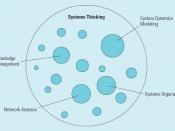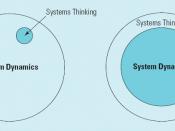Systems' thinking is derived from viewing elements and components that work together in relationships for the overall good of the vision or the whole. Every aspect of our lives is involved in a system whether it is electronics, biology, organizations, relationships, or ecology. By being able to recognize these systems we can focus on facts, not theories, and can look at a problem or issue understanding better where it came from, why it happened, and how to improve it. "Systems thinking is a discipline for seeing wholes, recognizing patterns and interrelationships, and learning how to structure those interrelationships in more effective efficient ways" (Senge, P., and Lannon-Kim, C., 1991).
We live in what may appear to be a hierarchy of living systems. Starting at a cell, organ, individual, group/ team, organization, social/ community, earth/ world. In actuality there is a connection between everything in existence. Everything/everyone is connected to something/someone.
One of my favorite examples of a system is the focus of the native culture. They use a circle to represent totality and view everything around them as part of their circle.
A dominant theme in all Native American Cultures is that of relationship or a series of relationships that are always reaching further and further out. Relationships within the immediate family reaching out to the extended family, to the band, outward again to the clan, and outward again to the tribal group. Relationships do not stop there but extend out to embrace and relate to the environment; to the land, to the animals, to the plants, and to the clouds, the elements, the heavens, the stars; and ultimately those relationships which people express and live extend to and embrace the entire universe. (Brown, 1993).
Native culture shows a great understanding of how their actions have and will affect the...


